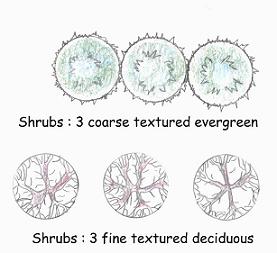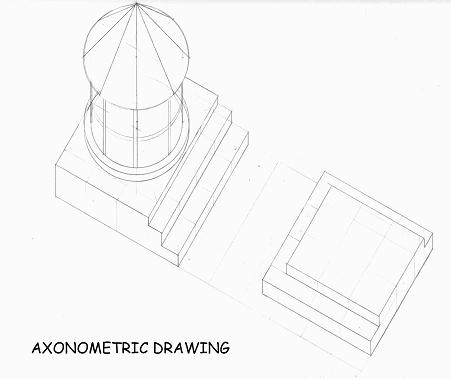Garden Drawing Made Easy
Good garden drawing practice forms the backbone of a garden design. The designer uses it to communicate the garden design to the landscaper. This page guides you through the basics of garden drawing. A good drawing is worth a thousand words. Get it right and your designs will shine!
Drawing Instruments
Standard drawing instruments include:
• Drawing board
• Set square
• Scale Ruler
• Compass
• Pencil 2H
• Colour pencils
• Eraser
• Paper
These instruments are the minimum you need. If you do not have some of the instruments, you will have to improvise. Various stencils could be used to provide texture to your final drawing.
Garden Drawing Symbols
Each garden designer develops her own set of symbols. This becomes her ‘trademark’. Symbols are needed to represent various types of plants, e.g. fine textured evergreen tree, conifer, etc. Develop your own set of symbols for use when you design gardens.

Garden Drawing symbols
Scale
Scale is the most important requirement for garden drawing. Always draw everything to scale. If you neglect scale your design will not adhere to the garden design principles. A common scale for medium gardens is 1:100. This means that 1cm on your drawing will represent 100cm (or 1 m) in the garden. For smaller gardens a scale of 1:50 is popular.
When drawing, select the correct scale on your scale ruler. If you do not have a scale ruler, keep to a simple scale like 1:100. Always write down the scale of your drawing on the drawing. This will prevent confusion later.
Layout
Lay your drawings out to fit properly on the page. Leave sufficient margin around it for comments or writing. Determine the overall size of the garden site, and then measure the size of your paper. Use a calculator to determine a good scale.
Dimensions
Write the overall dimensions on the outside of the drawing. Also write in any critical dimensions to make the positioning of hard landscape items easy. Dimensions are also important to calculate the amount of material to be purchased for paving, gravel paths, etc.
Elevations
Garden drawings are normally done in plan, i.e. the drawing as seen from above. This gives an overall layout of the garden. Here all things are shown in relation to their position on the ground. Dimensions are also easily measured on the drawing, scaled up and used for the final setting out of the garden.

Side elevations are useful for gardens that have different levels. The different heights are then easily recognisable. Side elevations are very useful for hard landscaping, like positioning of terraces.

An axonometric drawing portrays a 3 dimensional image of the garden. This elevation is very illustrative, but difficult to use in the actual landscaping of the garden. The technical aspects will not be discussed as this drawing will be of little use to you in your first few garden designs.

Color
The use of color in a garden drawing makes it interesting, and gives a feel for the garden design theme.
Attention: This is limited to the next 7 lucky individuals
“The FREE Shed Plan and Garden Improvement Project ”



